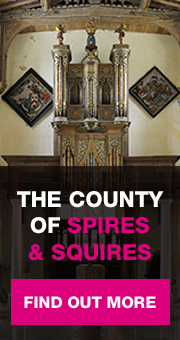24th May 2018
Is everywhere the same as everywhere else?
I've been putting off this walk for a while. It looks like hard work: a slog up the Leamington road into Daventry, and then navigation of the town's Milton Keynes-like periphery: roundabouts, grass verges, commerce, boxy houses and all. In the event it turns out to be less intimidating than a first, careless study of the OS made me think.
The old road out of Staverton soon winds back onto the modern highway. The trees and bushes are bursting into green life on every side. It's that exciting week when winter really turns into spring, although you wouldn't know from the ambient temperature, nearly twenty degrees down on last week's exceptional maximum. I'm swathed in sweaters. The tarmac roadside path takes me past the Staverton Park Hotel and golf resort. It's clearly a favourite with the conference crowd. The large car park is rammed with Sales Rep transport on this Thursday morning, Insignias and Focuses by the score. I'd have thought the 'De Vere Staverton Estate' would have demanded a re-branding of the prosaically named 'Big Hill' on the opposite side of the road. How about 'Trump's Head' or 'Mount De Vere' or 'FTSE Top'. So much classier.
I leave the main road through a layby and cross to a brief diversion along the remains of the older way out of Daventry, now just a footpath. I pass six or seven individuals walking the other way, perhaps workers at the De Vere. At home we've been watching BBC TV's 'Civilisations' series - with rapture when Simon Schama's presenting, somewhat more desultorily when Mary Beard or David Olusoga have been in charge. From our Gogglebox critical cheap seats we find Olusoga's style anachronistically didactic and his arguments sometimes less than convincing, although great as discussion starters. Oh my, how highbrow life is at the Crosses. Why not drop in sometime for an evening seminar on Derrida or String Theory. Such fun. Anyway...
Last week Olusoga mentioned a painting by Caillebotte neither of us knew: 'Paris Street: Rainy Day'. It shows people hurrying through the city, heads down and avoiding eye contact, against a striking backdrop of Hausmann architecture. Today none of the people I pass on the road to Daventry want to make eye contact either. This isn't the countryside default. Just a few hundred yards back in the village I'd swapped the cheeriest of greetings with two women on horseback. In towns people are scared, and sometimes with good reason. We too have been burgled, assaulted and sworn at. It was probably always so. Is it just over-close proximity that makes us mean? Or an enhanced awareness of what we have and haven't got?
The old Staverton road takes me across a pedestrian flyover into a traffic-calmed urban street, the houses going increasingly upscale as I approach the town centre, through an underpass to a previous era of building, and then past the old 'Coach and Horses' travellers' inn. It's being gutted, earth movers where the horses once lodged, perhaps for part-refurbishment as a pub, abut also partly because it's soon to be reborn as an apartment complex. As Daventry's road plan changed, the 'Coach and Horses' lost its function as a hostelry. Now it's on a road to nowhere.
Say 'Daventry' and I think 'radio station'. On Bakelite wirelesses of the fifties it was one of the many exotic-sounding locations printed on the dial along with 'Hilversum', 'Sundsvall' and 'Allouis' etc. etc. Until fifteen years ago, going north on the M1, the motorist passed an extensive array of radio masts all now dismantled - tho' I think the town is still a radio marker for Britain's busy air traffic control. Daventry strikes me as a liminal town, looking west more than east, an outlier in Northamptonshire's geography. The town's shops are the usual contemporary mishmash, at least in the older streets. In the arcade by the bus station you can find Boots, Waitrose and Greggs as you would in any comparable place. Elsewhere it's charity emporia, tattoo parlours and takeaways. The buildings are a bit of a jumble too - here a bit of handsome sandstone Georgian, there workaday nineteenth century and nineteen-sixties utilitarian. I order an Earl Grey and a slab of Cherry Bakewell from the cheerful women in the Courtyard Tearoom (alas too sweet even for me!) and fiddle with my latterly unpredictable I-phone to no great effect. I notice a chap with a clerical collar in an adjoining comfy chair. It's Nigel Fry, the incumbent at Barby and Kilsby. I explain myself briefly, and leave him with a card and the threat that I'll be 'down his way' soon. He deserves his peace and quiet (I thought I detected a certain hunted look in his eye when I said hello), although I suspect like me he'll find it hard not to tune into the intimate domestic details being shared with the world by two ladies-who-cake on another near-by table.
Up at Holy Cross church, the front door of the splendid Georgian edifice (1754) is open. I'm welcomed by a be-gowned steward who explains there's a funeral shortly. I'm sorry not to be able to spend more time looking around. Everything about the church's décor and presentation is friendly and enthusiastic in an embracing kind of way. Recorded music is playing quietly in the background. A discreetly positioned sound desk is tucked in behind the back pews. Fe-fi-fo-fum, I smell the amps of a worship band ( but Holy Cross's website begins its 'music' section with a great - and clean - Thomas Beecham quote, and they have a church choir too!) The whole place sparkles with light and warmth. Leaving aside any human element, why wouldn't you want to worship in a place like this?
I follow my nose downhill looking for the Ashby road out of town ( not Ashby-de-la-Zouch: Ashby St. Ledgers!) It's still really chilly, particularly when the sun's hiding. A brisk west wind has got up. I recall the one time I played cricket in Daventry, also in late April, the first game of a season with a rather smart-alick team, all manly exhortation and diving around in the outfield. The wind was positively howling across the ground. It was right in my face as I opened the batting, the pitch soft and wet. I made a big lonely blob, tamely prodding the ball to a waiting catcher in the first over. It was one of the most miserable afternoons I ever spent on a cricket field. I played a few more games in that lot's company without any discernible distinction, sliding down the batting order week by week, confidence shot to pieces, until finally I brushed the dust off my cricket boots and moved on. I have to like the people with whom I'm spending time. The activity is never enough by itself.
After three quarters of a mile I find what I'm looking for, the converted path of the old branch line from Long Buckby, heading north-west, now a green corridor for cyclists and walkers through the housing estates. Daventry is expanding, like all the other Northamptonshire towns, pushing out on all sides. On the way from Northampton out through Weedon, there are roadworks on both flanks of that village, part of the Daventry development plan, as if the countryside in between and beyond will one day soon be quite consumed by housing. And so Daventry will no longer be an 'outlier': it will be one with the Northampton Megalopolis as it pushes forward to Coventry. And Oxford. And Cambridge. The bones of the structure will soon be in place. The detail will follow and nothing now can prevent it, outside economic collapse, and even then, that possible disintegration would be offered as the rationale for the 'necessary' destruction of the countryside. I'm sorry to bang on endlessly about it, but if this blog is to add to the historical record in any tiny way, this has to be recorded as one of the most important national trends of the early twenty-first century.
I'm looking for a cross-track which I eventually find, but it's running along a viaduct fifty feet above me. I scramble up the steep and slippery sides of the old railway cutting, and walk a newly-made grassy way skirting the farthest extent of the housing. It eventually delivers me to the lane which once carried horses and people over the Braunston Tunnel on the Grand Union Canal. Below them the boats were 'legged' by their operators, who lay on boards and from an inverted position walked them from end to end - in this case through almost a mile and a half of tunnel. Not great for the digestion I wouldn't have thought. Apparently there's a bit of a wiggle in the middle, as there is at Blisworth, either because of difficulties with the soil, or miscalculation. At ground level the spire of Braunston's 'Cathedral of the Canals', All Saints, is dead ahead as I look down the green lane where it descends to meet the tunnel at its western portal.
Braunston is a first real taste of the Midlands as the traveller goes west. There's a lot of nicely weathered red brick, and much less yellow sandstone. The ginnels on the north side of the canal meander pleasantly between the cottages and eventually I gain the High Street, passing the old windmill, and arriving at All Saints to find Pat Milner one of the churchwardens waiting inside, drumming his fingers. A colleague has forgotten a promise to meet. We chat about this and that. They've just been through an interregnum: their new incumbent Nat White will be installed this Saturday. I say that we've just lost our lovely curate Allison who is to be installed this weekend too, and Pat and I get confused about dates. At any rate, the Bishop's working hard ( as I expect, creep, creep, he does every weekend!) Pat and I swap news about Marion and Keith Thomas, our former members at Weston Favell, who many years ago felt a calling to minister to canal folk, and made a temporary new home among them at Braunston, as you would.
I spend a few minutes just sitting in the beautiful breadth of All Saints' nave, looking around me. You could spend hours here, and still find new detail to stimulate and excite. The sheer quantity of symbolism in form, colour, fabric and glass is dazzling. This wealth of suggestion has been taken for idolatry, here in England and more widely around the world. As we know, courtesy of IS et al, wanton destruction is still going on. The Baptist church of my younger days would have been uncomfortable with what I see around me now. But for most of us, finding God in the desert is the hardest thing to do. My soul is relaxed and revived in this forest of images.
I walk back along the south side of the canal. Near to the entrance to the extensive marinas is a narrow boat café, the Gongoozler. I had no idea, but a gongoozler is a person who enjoys watching activity on the canals, but doesn't participate. That's me then! But there's no time for tea today.
Did the people of Braunston not get on with their counterparts in Staverton? The Jurassic Way follows a more or less north-south line from the one village to the other, but it was never metalled, and at times is no more than a one person path. Just to the north of Staverton, two-thirds up a two hundred foot climb from the stream at its bottom, there's a civic seat. It looks out across miles and miles of uninterrupted country patchwork, a glorious view, a national resource of food and emotional sustenance. For how much longer?
So is everywhere the same as everywhere else? (I'm asking myself!) Yes and no, Superficially, all Mozart sounds the same - and some music-lovers never get past this. Superficially all sheep look identical, except perhaps to the farmer. At first glance every town and village look alike to the world-weary traveller. But, as I remind myself, the more we look and listen, the more we identify difference. And then it strikes me, as if a new and revolutionary thought, the only near-clones are those we produce through our own human industrial processes - knives and forks, cars, photo-copies, 3-D printed artefacts, robot-produced books. Or am I still not looking closely enough? And what conclusions should I be drawing from this?
Snoozes on the pews: 19 km. 5.5. hours. 9-14 degrees C. Wind: 15 mph, gusting 25. No stiles, Ten gates. Maybe four bridges. Countless new-born lambs: a shout out to numbers 19 and 13 in a field near Braunston.
Your login details have been used by another user or machine. Login details can only be used once at any one time so you have therefore automatically been logged out. Please contact your sites administrator if you believe this other user or machine has unauthorised access.







